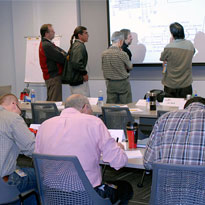LTE Network Planning
- Course:LTE Network Planning
- Course ID:LTE-NPC Duration:5 days Where: Your Office (7+ Persons)
- Download Course Description (PDF)
Available as a private, customized course for your group at your offices or ours and in some cases as a WebLive(TM) class.
Course Outline
- LTE air interface overview
- Air interface structure overview
- Air interface bit mapping
- Theoretical throughput calculations
- Exercises
- Services and QoS restrictions
- Identification of available services
- QoS restrictions based on 3GPP standards
- Traffic considerations
- Simulation results and simulators
- Most useful simulation curves
- Exercises
- Initial conditions: Operator details and requirements
- Setting up the initial planning case
- Filling up the customer requirements table
- Understanding the critical conditions for initial planning
- Uplink considerations: Throughput and capacity
- Throughput considerations
- Capacity considerations
- Operator capacity requirements
- Capacity estimation
- Practical exercises using simulation tool: Practice on different planning scenarios
- Expected Interference and SINR
- Intercell-interference estimation based on statistical counters
- Intercell-interference estimation based on simulations
- Intercell-interference estimation based on drive test measurements
- Intercell-interference estimation based on mathematical queue models
- SINR estimation algorithm based on simulations
- SINR for different MIMO configurations
- Throughput estimation based on statistical counters
- Throughput estimation based on queue models
- Throughput estimation based on real drive test measurements
- Uplink cell range
- Estimating worst cell edge scenario throughput
- Estimating average cell throughput
- Fulfilling customer requirements
- Uplink cell range estimation
- Recursive procedures to improve customer requirements
- Practical exercises using simulation tool: Practice on different planning scenarios
- Downlink considerations: Throughput and capacity
- Starting point: Uplink cell edge range
- Case study: Downlink throughput considerations fulfillment
- Capacity considerations: Operator requirements fulfillment
- Case study: Downlink throughput considerations not fulfilled
- Capacity considerations: Operator requirements not fulfilled
- General approach discussions
- Introduction to scheduler: Algorithm decision process
- Practical exercises: Case studies
- Downlink expected interference and SINR
- Intercell-interference estimation based on statistical counters
- Intercell-interference estimation based on simulations
- Intercell-interference estimation based on drive test measurements
- Intercell-interference estimation based on queue models
- SINR estimation algorithm based on simulations
- SINR for MIMO configurations
- Throughput estimations based on statistical counters
- Throughput estimations based on queue models
- Downlink cell range
- Estimating worst cell edge scenario downlink throughput
- Estimating average downlink cell throughput
- Fulfilling customer requirements
- Uplink cell range estimation
- Recursive procedures to improve customer requirements
- Practical exercises using simulator tools and MS Excel spreadsheets
- Control channel requirements
- Control channels air interface format
- Control channel SINR requirements based on simulations
- Control channel fulfilling conditions
- Cell range re-evaluations for control channel requirements
- X2-S1 transport capacity design: IP/Ethernet overview
- IP protocol description overview
- Ethernet protocol description overview
- IP/Ethernet backhaul bandwidth considerations
- Using IP/Ethernet for LTE transport
- Estimating bandwidth
- Choosing appropriate plug-in units hardware: Vendor specific
- Radio parameters and performance optimization
- LTE radio functionality overview
- LTE KPI’s overview
- Optimizing LTE scheduler functionality
- Optimizing LTE RLC/MAC throughput
- Wrap-up
- Course Recap and Q/A
- Evaluations
Course in a Nutshell
In this course, you will learn the key principles of cell planning and capacity calculations for an LTE network. Complete instruction will be provided to estimate LTE capacity and expected throughput considering all of the parameters that affect performance including MAC scheduler and SINR conditions. We will also consider control channels to fulfill certain threshold conditions. We will undertake capacity calculations related to expected bandwidth over IP transport. Throughout the course, we will use practical exercises and case studies to illustrate the planning concepts and techniques.
Customize It!
We can customize this course to your team’s technical goals, usually at no additional cost.
Aimed At
Radio planners, network design engineers, service design engineers, and others who can benefit from a detailed discussion of LTE network planning techniques and considerations.
Prerequisites
Those wishing to take this course should have a good knowledge of cellular systems, wireless communications and radio access technology.

